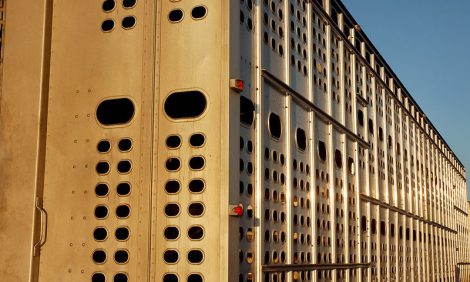



2011 Forecast: Trade Higher On Beef Demand
US - Exports of broiler meat, beef and pork are all forecast to rise, according to the Livestock and Poultry: World Markets and Trade report from the USDA Foreign Agricultural Service.
Broiler Meat: Exports are forecast moderately higher. Both the United States and Brazil have ample supplies and market access to satisfy rising imports by Russia, the Middle East and a number of markets in Asia. The strongest import growth is expected in Russia where the United States, its leading supplier, is expected to fill the tariff rate quota.
Beef: Exports are forecast to rise, reversing the trend of recent years. Production expansion by South America and India is expected to more than offset declines in North America and Oceania. However, growth in world trade continues to be constrained by tight supplies and Sanitary/Phytosanitary (SPS) restrictions. Imports in a number of countries are forecast higher as domestic supplies are tight. Also, continued economic recovery is expected to bolster Asian imports.
Pork: Exports are forecast just short of the record set in 2008. More competitive U.S. and Brazilian pork is expected to displace EU shipments, where rising costs of production result in lower exportable supplies. Global demand is expected to be slightly stronger with contracting Canadian production offset by larger imports and improving economic conditions stimulate Asian demand.
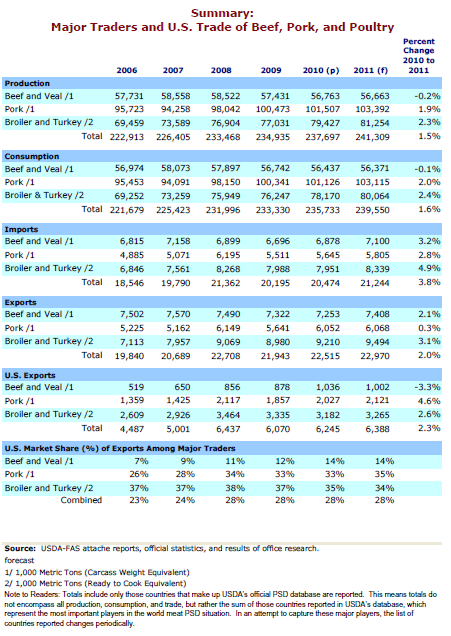
BEEF AND VEAL: 2011 FORECAST OVERVIEW
CATTLE:
Among major beef exporters, significant cattle herd expansion is forecast only for Brazil (3 percent), Australia (2 percent) and Argentina (2 percent) in 2011 with tempered gains by New Zealand (1 percent) and Uruguay (1 percent). The total of global cattle ending inventories (of countries continuously included in the PSD database) will rise as significant gains in these major exports outweigh moderate declines in many, but not all, other countries. Major beef importers, with the exception of South Korea, are forecast to continue their long term trend of declining cattle inventories.

SOUTH AMERICA: The historical expansion in the South American herd continues to be led by Brazil and Columbia which outweighed recent contractions in Argentina and Venezuela.
Over the past decade, Brazil’s cattle herd has expanded to support increased domestic and export demand. However, the decline in exports to the EU in 2008, from which Brazil has yet to recover, and constraints in shipments to Russia have impacted beef demand and the rate of increase in calf crop production slowed.
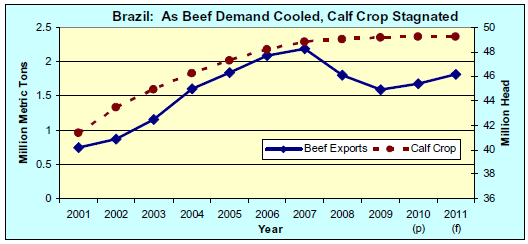
Current and expected firm cattle prices are expected to encourage Argentine producers to begin rebuilding depleted herds in 2011. Although the current forecast calls for a rise in the calf crop, smaller beginning inventories and cow retention will contribute to a drop in slaughter, which will shrink supplies for both export and domestic consumption in 2011. While more normal weather conditions have returned, government policies continue to slow sectoral investment, curtailing stronger expansion. Argentina began 2010 with sharply lower beginning inventories following a reduced calf crop and high slaughter in 2009 due to drought (which perpetuated continued high slaughter of cows) and government policies (which discouraged investment). The high profitability of field crops has resulted in the conversion of several million acres of pasture over the past five years and consequently feedlot production expanded to currently account for about 40 percent of slaughter. However, expected low returns due to unused capacity, an increase in government-mandated minimum slaughter weights, and the termination of subsidies is expected to adversely impact commercial feedlot production in 2011.
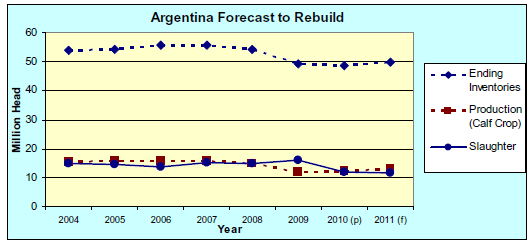
OCEANIA: Australia and New Zealand are recovering from drought supporting increased cattle production.
Herds in New Zealand are forecast to increase after declining in the previous year. Stronger forecast dairy and beef prices in 2010 are expected to support producer returns, leading to higher breeding herd retention.
Similarly, prospects for the Australian cattle industry have been remarkably transformed due to improved weather conditions experienced over the calendar year to date. Heavy rainfalls have dramatically improved soil moisture and pasture conditions as well as water storage levels. Since the return of more normal weather conditions, a surge in cattle inventories has already been recorded. Increases in ending inventories for 2010 and 2011 are forecast as producers withhold stock from slaughter for breeding purposes. This retention will put downward pressure on slaughter and thus beef production and exports; albeit somewhat constrained by higher weights due to improved conditions. Ending inventory for 2011 would be the highest since 1977.
NORTH AMERICA: U.S. inventories are forecast to decline again in 2011. Inventories have been declining since 2007 and higher cow slaughter and low breeding herd retention has precluded expansion. Although cow slaughter is expected to decline in 2011, current incentives to place heifers in feedlots rather than retain them for breeding is expected to preclude growth of the calf crop in 2011. Cattle inventories are expected to decline to 92 million head by the end of 2011.
Continuing the downward trend of recent years, the Canadian herd is forecast to end 2011 with lower inventories due to fewer beef cows and relatively low heifer retention. The calf crop is forecast to decline for the 6th consecutive year.
OTHER MAJOR BEEF EXPORTERS: India’s herd will remain relatively unchanged in 2011 despite marginally higher slaughter, due to a rising calf crop as producers keep cows in milk production. Dairy is the main driver of the livestock sector and its increasing milk products shortage is stimulating medium term growth in cattle and buffalo stocks.
BEEF:
World Production Virtually Unchanged; Marked by Tight Supplies
Among major producers, only Brazil, India and Mexico are forecast to expand beef production. However their growth, ranging from 2 to 3 percent, will not outweigh declines in other countries, resulting in another year of anticipated tight global supplies. For many key producers, reduced inventories are forecast to depress slaughter resulting in lower or unchanged beef production.
Brazil and India Forge Ahead and Expand:
A forecast increase in slaughter and trend towards higher weights is expected to raise Brazilian production. Brazil, like India, is one of the few countries with expanding inventories available for slaughter. Both are also countries which have strong and/or rising domestic demand while 2011 will exports account for 19 to 25 percent of production, respectively.
Declining Herds Generate Lower North American Production:
In the cases of the United States (the world’s leading beef producer) and Canada, declining cow inventories and calf crops over the past several years, are forecast to result in smaller pools of cattle available for slaughter. U.S. cattle imports are also expected lower, which will depress slaughter. However, Mexican production, driven by rebounding consumption, will not outweigh falling inventories in other NAFTA countries.
Oceania: Improved Conditions Not Forecast To Translate Into Increased Production:
Production is forecast lower on declining slaughter in Australia and New Zealand combined with expected lower average carcass weights as the mix of cattle slaughter changes.
Feed Availability and Costs Constrain Other Major Producers:
Higher feed costs and slow recovery of the EU economy are forecast to keep production unchanged. Similarly high feed and other input costs will continue to dampen Chinese production. Drought and elevated feed costs/shortages are also expected to constrain Russian production.
Production by Japan and Korea, Key Asian Importers, Treading Water or Rising:
Japanese production is forecast relatively flat on slightly lower slaughter due to weak demand for higher priced domestic beef in a slow economic recovery. The Miyazki FMD (Foot and Mouth Disease) outbreak will not have any significant impact on the coming year. Korean production is forecast significantly higher, up 11 percent. Live Hanwoo cattle prices are expected to continue to decline, although they are still relatively high compared to 2008 and most of 2009. Domestic cattle prices are depressed as economic uncertainty impacts consumption, confidence in imported beef is up, and the butcher shop restaurant business has slowed. In response to softer prices, slaughter is forecast though higher as producers cut inventories. Despite the expected increase in slaughter, ending cattle inventories will be higher due to strong growth in the calf crop.
Trade: Demand Higher But Tight Exportable Supplies Constrain Growth
Exports in 2011 are forecast to rise 2 percent, reversing the downward trend of recent years. Demand is generally rising slightly in most key markets, but is constrained by tight exportable supplies, high prices and SPS restrictions.
IMPORTS
Limited Growth Opportunities in Korea, Japan and Russia
Korean consumption is forecast to rise generating opportunities for imports, but high domestic and international prices are expected to dampen further growth. Continuing economic recovery is forcing consumers to increase consumption of imported cuts. Local retail beef prices are generally two to two and a half times more expensive than imported beef which should favor demand for imported beef. Further, concerns over imported U.S. beef have dissipated with the United States currently holding about 30 percent of the market. The implementation of a traceability system and strict country-oforigin labeling requirements in restaurants, as well as marketing, has helped restore consumer confidence in imports.
With Japanese consumption and domestic production forecast unchanged, little import growth is forecast. This increase may be largely captured by Australia due in part to its competitive prices. U.S. supplies are constrained by Japanese imposed BSE-related age restrictions.
Due to declining production, slightly higher imports are needed to maintain Russian consumption, which is forecast to remain below the 2008 level. Shipments are expected to exceed the tariff rate quota.
Mixed Results in North America
With production expected to decline and a strong dollar vis a vis the U.S. dollar, Canadian imports are forecast higher. However, Mexican imports are forecast lower as increased production will exceed slightly higher consumption. Declining U.S. production and economic recovery will push imports higher, although severely constrained by tight supplies out of Oceania and Canada.
Other Markets Continue to Expand
Venezuelan imports remain strong and is forecast slightly higher as production continues to be decline, albeit at a slower rate. Personal and legal insecurity, high inflation (of input costs), low controlled meat prices and reduced investment constrain production. Consequently, imported meat accounts for about one-third of domestic supplies. That does not account for imports of live cattle which account for about two-thirds of domestic slaughter. Thus, imported meat and cattle account for an estimated 75 percent of Venezuelan beef supplies. As a result, even slight changes in consumption, bilateral relations and prices can have a significant impact on the import forecast.
Iranian imports, largely from Brazil although also some smaller shipments from India, more than doubled in 2010. Growth in 2011 is expected to be relatively small with more modestly higher consumption. Imports are rising not off declining production but rather as a result of increasing consumption.
Egyptian imports are forecast to continue to grow as an improving economy stimulates meat consumption to return to expand and domestic production is unable to keep pace. Higher beef prices spurred cow slaughter in 2010, depleting supplies of cattle available for slaughter, which will not be replaced by higher imports of live cattle. Although consumers prefer beef to other meats, they also prefer fresh domestic beef. However, since much is consumed in stew-type dishes, price is often a driving factor in purchasing decisions. Thus, lower-income consumers are more willing to consume imported frozen beef.
No Growth in EU Imports
As EU beef production declines slightly, imports will be unchanged as they are constrained by limited supplies from major traders and the weak Euro. Higher domestic prices and the recession caused lower as consumption has shifted to lower-priced cuts, such as ground beef, and alternatives such as poultry.
EXPORTS
As a result of production declines in many key exporting countries, only Brazil and to a much lesser degree India, Paraguay and Uruguay have the available supplies to expand exports.
Forecast Growth in Indian and South American Supplies Support Higher Demand
Brazil is forecast to rise exports 8 percent, benefiting from small increases across a wide swath of countries including the EU, Egypt, Russia and Venezuela. As the only major trader with larger available supplies, it could capture rising demand in much of the world, as well as benefit from unchanged or lower supplies by key traders such as Argentina. The Paraguayan and Uruguayan situations are parallel, but with substantially smaller herds are not able to increase shipments as significantly. Indian exports are forecast slightly higher in 2011 but are constrained largely by limited market access, compared to South America, and also exports carabeef (from water buffalo) compared to traditional beef (from cattle).
Tight Supplies Constrain The United States, Canada and Oceania
The United States, with significantly reduced production (2 percent), is forecast to experience its first decline in exports since 2004. However, exports as a share of production will remain at about 9 percent. Exports to Asia are expected to remain strong.
While Australian exports are forecast unchanged, shipments to key Asian markets will remain at same or higher levels. New Zealand shipments are forecast to drop on lower supplies, likely resulting in reduced shipments to Japan and Korea, although higher shipments to the United States.
Canadian exports are forecast a modest 1 percent higher as tight supplies in the United States coupled with economic recovery, resilient demand in Asia and high world prices support increased trade. However, lower meat production and a stronger dollar could impair their comparative advantage.
TRADE:
Exports are forecast 3 percent higher to a record of nearly 9 million tons due a reduction in SPS barriers, as well as economic growth and recovery. Expansion is fuelled by demand from virtually all major and emerging markets, and both the United States and Brazil will benefit as major suppliers.
The United States and Brazil are forecast to account for over 70 percent of exports by major traders. The combined share of trade by these two exporters is expected to be slightly less than 5 years ago.
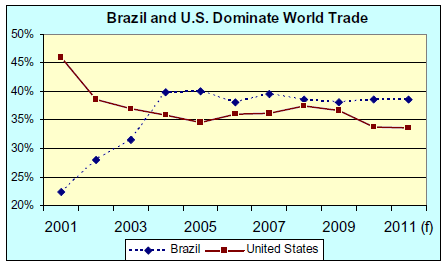
United States and Brazil Grow at Same Pace (3 Percent):
U.S. exports are forecast at 3.0 million tons; reversing the recent downward trend.
- The strongest growth is expected in shipments to Russia as the United States is expected to fill its tariff rate quota allocation set at 446,400 metric tons. Despite strong domestic production, its imports are expected to rise on resolution of SPS issues.
- As its main supplier, the United States will also benefit from a forecasted rise in Mexican imports. Raw material demand from the food processing industry is growing as consumption patterns mature due to rising incomes and urbanization.
Brazil remains the leading exporter, with growth expected at 3 percent, relatively on par with the past three years.
- Growth is primarily due to robust demand by Middle East markets as rising incomes and economic expansion stimulate imports by Saudi Arabia, the United Arab Emirates and Iraq.
- Shipments to China are likely to increase, but are not expected to fully replace U.S. product displaced by anti-dumping and countervailing duties.
- Emphasis on emerging markets will continue to fuel expansion.
Further Reading
| - | You can view the full report by clicking here. |
October 2010


